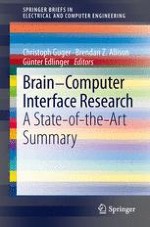2013 | OriginalPaper | Chapter
Utilizing High Gamma (HG) Band Power Changes as a Control Signal for Non-Invasive BCI
Authors : M. Smith, K. Weaver, T. Grabowski, F. Darvas
Published in: Brain-Computer Interface Research
Publisher: Springer Berlin Heidelberg
Activate our intelligent search to find suitable subject content or patents.
Select sections of text to find matching patents with Artificial Intelligence. powered by
Select sections of text to find additional relevant content using AI-assisted search. powered by
